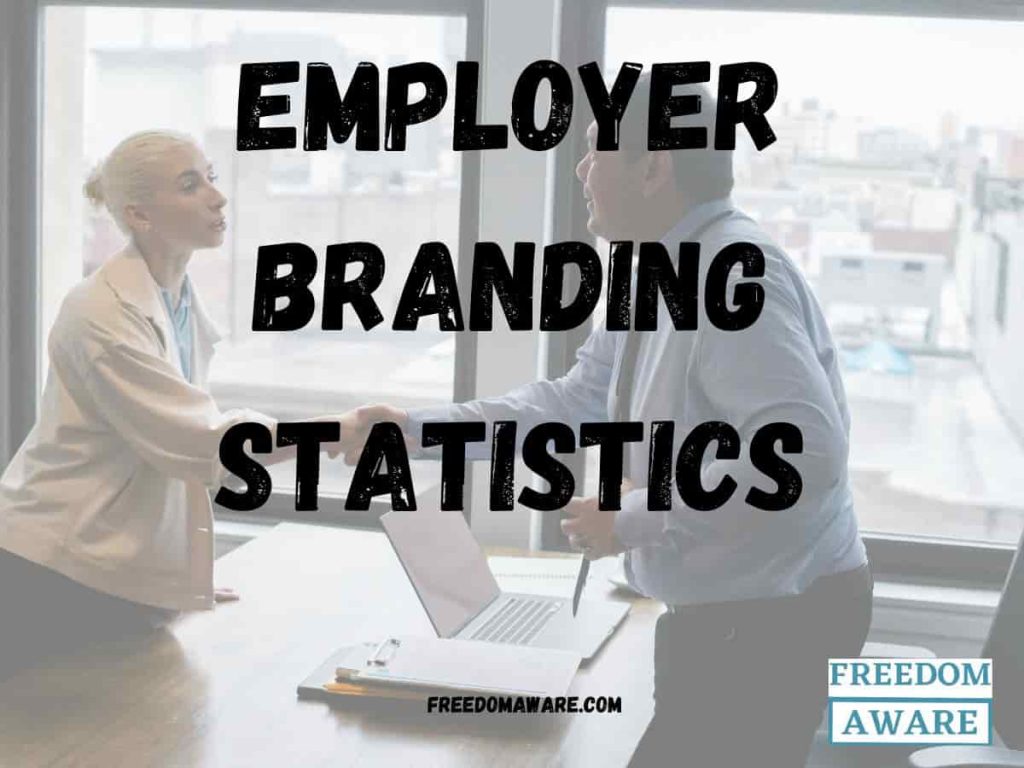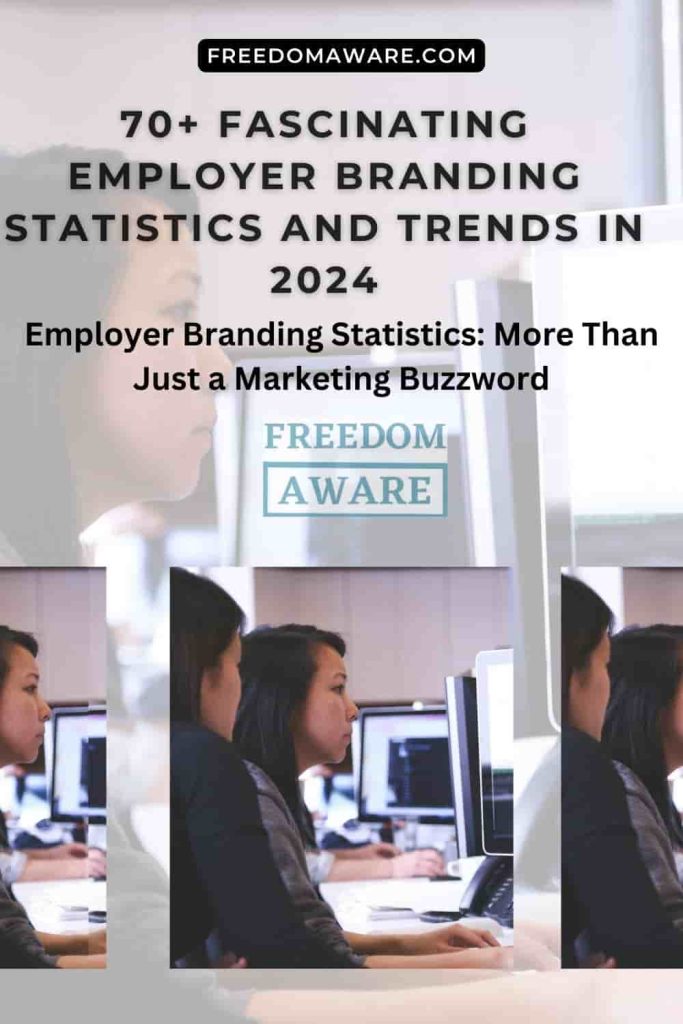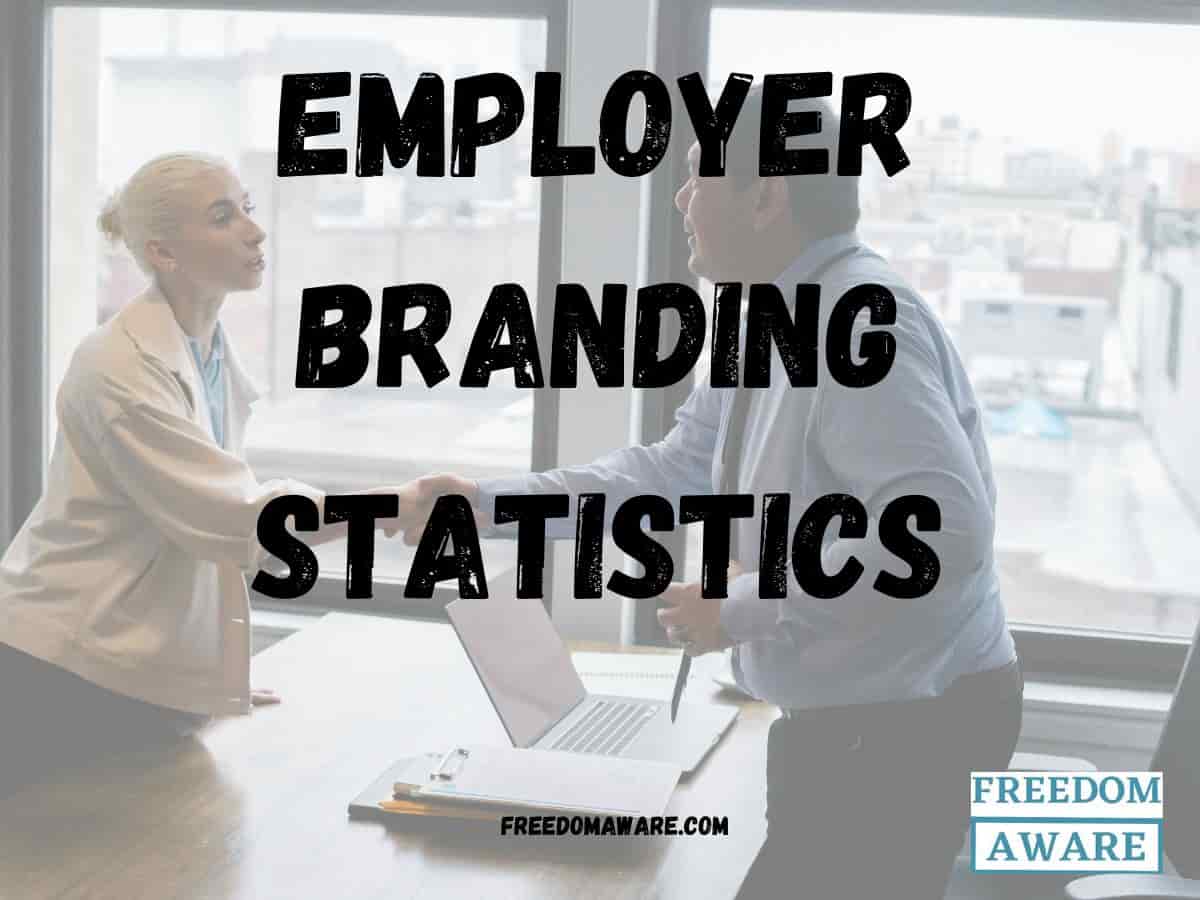
Employer Branding Statistics: More Than Just a Marketing Buzzword
Employer branding isn’t merely a marketing tactic; it’s the heart and soul of a company’s identity. It’s the promise of an experience, the reflection of a company’s values, and the magnet that attracts top talent.
Imagine joining a company based on a carefully crafted image, only to find a stark contrast between the advertised culture and the reality. This disconnect can be devastating for both the employee and the company.
A strong employer brand is crucial for attracting and retaining top talent. It goes beyond simply filling positions; it’s about building a team that shares the company’s vision and contributes meaningfully to its success. In the following sections, we’ll delve deeper into the importance of employer branding and explore strategies to build a compelling employer brand.
Employer Branding by the Numbers: Key (Employer Branding Statistics)

Employer branding is more than just a buzzword; it’s a strategic imperative. These key statistics underscore its significance in today’s competitive talent landscape:
- Employer Brand Drives Job Applications: A robust employer brand is a powerful magnet for top talent. Over three-quarters of job seekers (76%) research a company’s employer brand before applying.
- The Impact of Positive Employer Reputation: A strong employer brand significantly increases job application rates. An overwhelming 96% of job seekers are more likely to apply for a role at a company with a positive reputation.
- The High Cost of a Poor Employer Brand: A lackluster employer brand can lead to high turnover rates. 92% of employees are open to exploring new opportunities if a company with a better reputation comes along.
- Leveraging Employee Advocacy: Employees are your brand ambassadors. 72% of employer branding teams utilize their employees to promote the company culture and values.
- Gender Disparities in Employer Expectations: Women are more likely (19%) to seek new employment due to a perceived lack of opportunities, highlighting the need for inclusive employer branding.
- The Great Resignation and Flexible Work: The pandemic has shifted employee priorities. 76% of people are open to new job opportunities if flexible work policies are reversed.
- Total Rewards Package: While salary remains crucial (61%), factors like work-life balance (57%), job security (55%), and a pleasant work atmosphere (54%) are increasingly important. Women emphasize a positive work environment (59% vs. 50% of men).
- Beyond Salary: To enhance employee satisfaction and retention, 22% of employees desire additional perks like salary protection and fair compensation.
These statistics underscore the critical role of employer branding in attracting, retaining, and engaging top talent. By investing in employer branding, companies can create a powerful competitive advantage.
Employer Branding: Key Statistics and Trends
Employer branding has evolved into a critical component of a company’s overall strategy. Here’s a data-driven snapshot of its impact:
The Power of Employer Branding (Employer Branding Statistics)
Job Seeker Behavior (Employer Branding Statistics):
- A majority (76%) of job seekers research a company’s employer brand before applying. (source)
- LinkedIn is a primary tool for job searches, utilized by over 75% of recent job changers. (source)
- Company websites and social media are initial research points for 52% of job applicants. (source)
Employer Brand Challenges and Opportunities (Employer Branding Statistics):
- Talent acquisition leaders recognize social and professional networks as powerful tools for employer branding (68%). (source)
- The primary challenge for job seekers is understanding a company’s work environment and culture. (source)
- The focus is shifting from employee engagement to employee experience, with 55% of professionals recognizing this trend. (source)
- Acquiring top talent is a significant challenge for 40% of employer branding professionals. (source)
- Negative reviews deter job seekers, with 87% hesitant to apply to companies with negative feedback. (source)
Employee Preferences and Expectations (Employer Branding Statistics)
What Employees Value (Employer Branding Statistics):
- Wages remain the top factor in job offers (61%). (source)
- Work-life balance (57%), job security (55%), and a positive work atmosphere (54%) are increasingly important. (source)
- Women place a higher value on a pleasant work atmosphere (59% vs. 50% of men). (source)
- Opportunities for growth and development are crucial for 22% of employees. (source)
The Rise of Remote Work and Flexibility (Employer Branding Statistics):
- 76% of people are open to new job opportunities if flexible work policies revert. (source)
- 42% of candidates won’t apply for roles without their preferred working model. (source)
The Role of Technology in Employer Branding (Employer Branding Statistics)
- AI Adoption: While still in its early stages, 20% of employer branding professionals use AI, with another 15% considering it. (source)
- Employee Advocacy: 72% of employer branding teams leverage employees as brand ambassadors. (source)
- Video Content: There’s a growing preference for video content (42%) to understand company culture. (source)
Diversity and Inclusion in Employer Branding (Employer Branding Statistics)
- Gender Disparities: Women are more likely (19%) to perceive a lack of opportunities compared to men. (source)
- Reskilling and Upskilling: 69% of workers, especially younger generations, prioritize reskilling opportunities. (source)
Employer Branding in a Global Context (Employer Branding Statistics)
- Global Adoption: Over half (53%) of HR professionals in Brazil have employer branding strategies. (source)
- Brand Guidelines: In the US, only 30% of companies have established brand guidelines. (source)
- A significant disparity exists in AI training adoption across generations. While 32% of individuals aged 25-34 actively participate in regular AI training sessions. (source)
- this figure drops dramatically to just 5% among Baby Boomers. (source)
These statistics underscore the evolving landscape of employer branding. Companies must adapt their strategies to meet the changing expectations of the workforce, leveraging technology and employee advocacy to build a strong and compelling employer brand.
The Impact of Employer Branding on Talent Acquisition and Retention (Employer Branding Statistics)
- Employer Brand as a Deciding Factor: A strong majority (76%) of job seekers prioritize research into a company’s employer brand before applying. (source)
- Digital Age Job Search: LinkedIn has become a dominant platform in job searches, utilized by over 75% of recent job changers. (source)
- Employer Brand Dissemination: Talent acquisition leaders recognize the power of social and professional networks (68%) in promoting employer brands. (source)
- The Job Seeker Journey: Company websites and social media are initial touchpoints for 52% of job applicants. (source)
Challenges in Employer Branding (Employer Branding Statistics)
- Understanding Company Culture: Job seekers struggle to grasp a company’s work environment and culture. (source)
- Talent Acquisition Difficulties: Securing top talent is a challenge for 40% of employer branding professionals. (source)
- Leveraging Employee Advocacy: 72% of employer branding teams utilize employees as advocates. (source)
- identifying and engaging top talent remains a challenge (30%). (source)
The Evolving Workplace and Employee Expectations (Employer Branding Statistics)
- Shift from Engagement to Experience: The focus is shifting from employee engagement to employee experience, recognized by 55% of professionals and desired by 77% of job seekers. (source)
- The Great Resignation and Talent Mobility: A significant number of employees (84%) considered leaving their jobs for better opportunities. (source)
- while 92% would consider switching to a more impressive employer brand. (source)
- Work-Life Balance and Flexibility: Flexible work arrangements (76%) and job security (55%) are increasingly important to employees. (source)
- with women placing a higher emphasis on work-life balance (59% vs. 50% of men). (source)
- Employee Development and Growth: Opportunities for growth and development are crucial for 69% of workers, particularly younger generations. (source)
The Role of Technology and Diversity in Employer Branding (Employer Branding Statistics)
- AI Adoption in Employer Branding: While still in its early stages, 20% of employer branding professionals use AI, with another 15% considering it. (source)
- Video Content and Employee Advocacy: There’s a growing preference for video content (42%) in understanding company culture. (source)
- 72% of employer branding teams leverage employees as advocates. (source)
- Diversity and Inclusion: Women are more likely to perceive a lack of opportunities (19%), and there’s a need for greater focus on diversity and inclusion in employer branding strategies. (source)
Industry Trends and Challenges (Employer Branding Statistics)
- Job Search Platforms and Channels: While Indeed remains the most popular job portal (56%). (source)
- recruitment agencies (41% in APAC, and 19% in Latin America) are gaining traction. (source)
- Sectoral Differences: Retail and hospitality have higher perceived accessibility for job seekers compared to sectors like chemicals and life sciences. (source)
- The Rise of Remote Work: White-collar workers experienced a more significant decline in remote work compared to blue-collar workers. (source)
Key Priorities for Employees (Employer Branding Statistics)
- Compensation and Benefits: Salary remains the top priority (61%) (source)
- followed by work-life balance (57%). (source)
- and job security (55%). (source)
- Work Environment: A pleasant work atmosphere is crucial for 54% of employees, with women placing a higher value on it. (source)
- Career Growth: Opportunities for reskilling and upskilling are important to 76% of workers, particularly white-collar employees. (source)
These statistics highlight the evolving landscape of employer branding and the increasing importance of creating a positive and inclusive workplace culture to attract and retain top talent.
- Employer Brand Drives Job Seeker Behavior: 88% of job seekers consider a company’s employer brand before applying. (source)
- The Power of Social Media: LinkedIn is a dominant platform for job searches (75%). (source)
- while company websites and social media are initial research points for 52% of applicants. (source)
- Building a Strong Employer Reputation: Companies with positive employer brands are three times more likely to make quality hires and enjoy a 50% decrease in cost-per-hire. (source)
- Employee Satisfaction and Loyalty: Employees who understand and connect with their company’s mission are 67% more engaged. (source)
- a positive employer brand can boost employee referrals by 51%. (source)
- Diversity and Inclusion: 78% of companies prioritize diversity to enhance their employer brand. (source)
- while 67% of job seekers consider workplace diversity a crucial factor. (source)
- The Power of Employer Brand: 69% of job seekers would turn down a job offer from a company with a poor reputation, even when unemployed. (source)
- Impact on Turnover: Companies boasting strong employer brands experience a 28% reduction in turnover rates. (source)
- The Digital Age Job Seeker: 64% of job seekers won’t consider a company without an online presence, highlighting the importance of a robust digital footprint. (source)
- Transparency and Company Culture: 76% of candidates prioritize understanding team culture and values before accepting a job offer. (source)
- Cost Efficiency: Companies with a robust employer brand can significantly reduce hiring costs by up to 50%. (source)
- Talent Retention: A positive employer brand can increase employee retention rates by 28%. (source)
- Accelerated Hiring: Streamline your recruitment process with a strong employer brand, reducing time-to-hire by up to 50%. (source)
- Candidate Attraction: A remarkable 76% of job seekers prioritize a company’s reputation when considering employment opportunities. (source)
- Recruitment as a Marketing Function: HR professionals increasingly recognize recruitment as a marketing discipline (86%). (source)
- Candidate Journey: A Marketing Funnel: Understanding the candidate journey is crucial. 48% of job seekers use social media to research company culture before applying, mirroring traditional marketing funnel behaviors. (source)
- Employer Reputation Management: A company’s response to reviews significantly impacts its employer brand (67%). This echoes the importance of reputation management in marketing. (source)
- Culture as a Competitive Advantage: A strong company culture is a powerful differentiator (82%), similar to how unique value propositions drive product differentiation in marketing. (source)
- Employer Branding: The Key to Talent Acquisition: 89% of HR leaders recognize employer branding as a competitive advantage in attracting top talent, mirroring the role of brand building in driving sales. (source)
Shaping Your Company’s Future (Employer Branding Statistics): Top Employer Branding Trends for 2024
In today’s fiercely competitive talent market, a strong employer brand is no longer a luxury but a necessity. To stay ahead, companies must adapt to the evolving landscape. Let’s explore the key trends shaping employer branding in 2024.
Employer Branding Trends (Employer Branding Statistics): Shaping the Future of Work
Employer branding has evolved from a mere marketing tactic to a strategic imperative. Here are some key trends shaping the landscape:
The Rise of Employer Value Proposition (EVP) (Employer Branding Statistics)
- Defining Your Company’s Promise: EVP encapsulates a company’s unique value offering to employees, encompassing benefits, culture, growth opportunities, and work-life balance.
- Employee Well-being: A strong EVP prioritizes employee well-being with initiatives like generous leave policies, employee assistance programs, and wellness initiatives.
Diversity, Equity, and Inclusion (DEI) as a Business Imperative (Employer Branding Statistics)
- Building a Strong Reputation: DEI initiatives are essential for building a positive brand reputation and fostering trust with customers and employees.
- Driving Business Success: A diverse and inclusive workplace fosters innovation, creativity, and better decision-making.
The Impact of AI on Employer Branding (Employer Branding Statistics)
- Recruitment Revolution: AI is transforming recruitment by automating tasks, improving candidate matching, and enhancing the overall candidate experience.
- Data-Driven Insights: AI-powered analytics provide valuable insights into employer brand perception, enabling data-driven decision-making.
The Evolving Role of the Employee (Employer Branding Statistics)
- Employee Experience as a Top Priority: The focus has shifted from employee engagement to employee experience, emphasizing overall well-being and job satisfaction.
- The Power of Employee Advocacy: Employees are becoming powerful brand ambassadors, sharing their experiences on social media and influencing potential candidates.
The Changing Job Market (Employer Branding Statistics)
- Talent Shortage: The competition for top talent is fierce, with companies vying for the best candidates.
- Remote Work and Flexibility: Flexible work arrangements are increasingly in demand, with a significant impact on employer branding.
- Employee Expectations: Employees prioritize work-life balance, job security, and opportunities for growth and development.
These trends highlight the dynamic nature of employer branding. To thrive in today’s competitive landscape, companies must prioritize employee experience, embrace diversity and inclusion, and leverage technology to build a compelling employer brand.
Employer Branding: The Cornerstone of Business Success (Employer Branding Statistics)
Employer branding is more than just marketing; it’s the foundation of a thriving organization. By aligning a company’s values, culture, and employee experience, it fosters a powerful connection with both current and potential employees.
A strong employer brand is a strategic asset that drives business growth. It attracts top talent, boosts employee retention, and enhances a company’s reputation. By prioritizing employer branding, organizations can create a workplace where employees feel valued, engaged, and motivated to contribute to the company’s success.
Ultimately, a strong employer brand is a win-win for both employees and the company.



Leave a Reply